
MAY CONTAIN NUTS

Search Shorpy
SHORPY ART

Framed or unframed, desk size to sofa size, printed by us in Arizona and Alabama since 2007. Explore now.
Join and Share
Ad-Free Shorpy
Shorpy is funded by you. Patreon contributors get an ad-free experience.
Learn more.

Recent comments
- Recent view
- Hudson’s Big Store
- Say what??
- Grapes?!
- A Beautiful Moment
- Such joy
- Bethune-Cookman University today...
- Yellow sky at morning
- Side Winder
- Air Quality?
- Sojourner Truth riot
- None were so blind(ed)
- The less famous sister
- Good ol' days?
- Rise and Fall
- Goo Goo Ga Joob
- Ticket Retention
- Not the only one
- Vagaries of War
- Killed by Amtrak
- Back to the Future
- Wanted --
- If you can't stand the light
- Centralized Traffic Control, I believe
- What's really happening
- Heckuva remote control!
- Sometimes — Things Go Bump!
- I SEE THE LIGHT
- Union Switch and Signal Company
- Get That Light Out Of My Eyes
Member Photos
The Shorpy
Print Emporium
Print Emporium
Search Shorpy
Search results -- 30 results per page
- At Anchor: 1919
- ... car maker in 1917, went wheels-up in 1922.
San Francisco, 1919. "Saxon touring car at boatyard." Today's entry on the Shorpy ... Posted by Dave - 07/31/2017 - 5:59pm -
![At Anchor: 1919 Saxon, the seventh largest American car maker in 1917, went wheels-up in 1922.
San Francisco, 1919. "Saxon touring car at boatyard." Today's entry on the Shorpy Roster of Musty Marques. 5x7 glass negative by Chris Helin. View full size.
Star Plated in 1919The encore of the car and gentlemen previously seen along the docks here. With the license plate now visible we know that the vehicle belonged to Mr. Charles E. O'Day of 1763 Geary Blvd., San Francisco. At the time the photo was taken he was a salesman at DuBroy Motor Company, Inc.
DuBroy Motors started out as the Saxon Sales Company circa 1916 at 690 Van Ness. President and general manger was Francis Louis DuBroy. By 1917 the company had moved to 1529 Van Ness Ave which was the southeast corner of Van Ness and California at the time. In addition to the Saxon the dealership was also selling Nash automobiles. By 1920 the firm had relocated again to 1290 Sutter with a service department at 1615 Pine. The old location on Van Ness became the Pacific Nash Motor Company so it appears that DuBroy either lost or sold his Nash distributorship.
Prior to working at DuBroy Motors Charles O'Day had worked as a chauffeur since at least 1909. He stayed on at Pacific Nash when DuBroy moved his business, and he later became the sales manager for the dealership. We know he left that firm around the year 1933 as he had become the sales manager for James W. McAlister Chrysler and Plymouth by sometime in either 1933 or 1934. He remained there into at least 1944. By 1945-1946 he was with George S. Daniels Pontiac Motor Sales which became Weltner Pontiac circa 1954. Weltner was located across the street from the former DuBroy dealership when it was on Van Ness with an address at 1560 Van Ness (with street renumbering still at California & Van Ness).
So, 25 years after O'Day started selling cars, he was right back where he began. He remained at Weltner into at least 1954, but he later sold cars at McAlister Buick from about 1955 - 1958 and Volkswagen cars for Reynold C. Johnson during the years 1959 - 1968. By 1971 he was retired, he died on September 2, 1982, and he was buried in Colma, California along with his wife Leona who died in 1976.
A feature in the UPI archives on the 75th anniversary of the 1906 San Francisco Earthquake included a story from O'Day. "Charles O'Day told of how his family lost their house but happened to have crates of dishes in the wreckage. In the following months, the dishes were sold piece by piece and produced $1,600 with which the family opened a restaurant."
Vanity License PlateThe 'STAR' embossed on the license plate indicates the men were law enforcement officers, detectives, etc.
[No, the star is a validation tab to indicate vehicle registration for the year 1919. -tterrace]
Getting in on the ground floor...as a Saxon dealer in the small town of Waldron, Arkansas, circa 1914.
(The Gallery, Boats & Bridges, Cars, Trucks, Buses, Chris Helin, San Francisco)](https://www.shorpy.com/files/images/SHORPY-1200.thumbnail.jpg)
- Christmas Story: 1919
- ... "Nutcracker" 1915 PBS has been broadcasting San Francisco Ballet's Edwardian "Nutcracker."
The conceit is to set this ... Posted by Dave - 09/13/2011 - 4:34pm -
![Christmas Story: 1919 December 1919. "Baker Christmas tree." Secretary of War Newton Baker, wife Elizabeth and children Jack, Betty and little Peggy. National Photo Company Collection glass negative. View full size. More Xmas awesomeness here.
We hardly Newt yePreviously Mayor of Cleveland, this is the man responsible for the draft.
Lovely, butWhat a lovely picture! Isn't it odd though, the contrasts in this shot. There is such finery: the wife's dress and shoes are gorgeous as are most of their clothes, but then you have such a threadbare rug and things are a bit worn around the edges -- check out the leg of the chair Mrs. Baker is sitting on. Was that normal, do you suppose, for the tree to be so large that it sort of smashed against the ceiling like that?
If he only knewBet little Marconi there could not even imagine that in less than 90 years, ordinary kids his age would have their own iPods, CDs and Bluetooth gadgets. Great little piano there also. Nice family and it looks like everyone got what they wanted. Of course, as in my own childhood, kids got ONE present per child, not 15 or 20. Try doing that today.
Contest Entry?A neighborhood Clumsy Christmas Tree Contest is the only reasonable explanation for this grotesque tree.
Rock on!Looks like little Jack got the 1919 equivalent of an iPod for Christmas.
Charlie Brown calledand he wants his tree back. I don't mean to be a Christmas tree snob, but that is one ugly piece of vegetation. Plus the fact it looks like they spent about five minutes decorating it. Bah Humbug.
What Would Jackie Do?Newton D. Baker House, also known as Jacqueline Kennedy House, was built in 1794. It was home to the Secretary of War from 1916 to 1920 while he presided over America's mass mobilization of men and material in World War I. After the assassination of John F. Kennedy in 1963, Jacqueline Kennedy purchased the house and lived here for about a year. It was declared a National Historic Landmark in 1976. The house has many architectural details including a wide limestone stairway, pink-painted lintels with keystones, brick voussoirs, Doric pilasters and a semi-elliptical fanlight.
That Christmas treewas decorated in fifteen minutes or less.
Some things never changeJack would be just as comfortable today as he was in 1919. Only the headphones that he would have today would prevent any outside noise (his parents) from interfering with the volume. The other difference would be his attire, a T shirt and jeans would be acceptable. The other thing that would be the same would be his oldest sister, who would be nagging him big time.
It's the DickensI think I see the ghost of Christmas past.
The contrastbetween the shabby surroundings and the largesse bestowed on these obviously beloved children is stunning.
The firm that Jack builtNewton D. Baker was the mayor of Cleveland from 1912 to 1915 and Secretary of War from 1916 to 1921. His son Newton Diehl "Jack" Baker III founded the law firm of Baker & Hostetler, the 94th largest law firm in the world today.
Radio for the kiddies!Washington Post ad from December 14, 1919. Wireless telegraphy/telephony sets for the kiddies, and Christmas lights!
[Note that the name of Parezo Electric is misspelled. - Dave]
Dear SantaI would like a pair of shoes just like Mrs. Baker's.
Thank you!
Well, isn't that delightful?!There's young Jack, tuning his new crystal set with the "cat's whisker" (no doubt using the strands of metallic tinsel as a receiving antenna), as his little sister, wearing her first wristwatch, tinkles the ivories on her new midget Steinway grand.
Meanwhile, elder sister Betty daydreams about her boyfriend as she rips pine needles off a branch -- "He loves me, he loves me not ... "
Aah, Christmas!
Jack at the wirelessreminds me of myself 50 years later! I had a record player for a present at that age. Took it with us on the family summer vacation. I grew up to be a sound engineer; wonder what Jack turned out to be?
Were things really that drab in 1919Mabye it's the black and white photography but I find this photo oddly depressing. I think it's because of how the wallpaper and carpet photographed. The dresses the females are wearing however are beautiful (especially the little girl's). You can't buy that kind of cloth today.
Branches here and thereToday, we would never settle for a tree as unsymmetrical as this.
Miniature ChristmasVery interesting to see the downsized piano and the bed. Dad doesn't want Mother to stand up. If she does he will also be in miniature. Also, someone else write about the tree.
Artificial Christmas trees.I think we have found the reason for artificial Christmas trees. I wouldn't let that tree in my house. That piano would be worth a small fortune today.
Is it really THAT bad?There have been a lot of comments about the drabness and tattered finery in this pic, but I wonder if a lot of it simply has to do with the quality of the negative. Is the rug really threadbare, or could the sheen or design of it appear to be so, when in fact it was in acceptable condition. It hardly seems fitting that the Secretary of War would live on the verge of poverty. I know this will raise some cackles among purists, but how about one of you colorizers taking this photo to task and see if we can't really find the Christmas spirit in it.
This is what happens when you let the children choose the tree and decorate it themselves.
Xmas AskewNot only is that tree as crooked as a dog's hind leg (something I remember my brother complaining about when we would go looking for a tree when I was a kid), it also looks like it's tied to the light fixture on the wall to keep from falling over. Charlie Brown really does come to mind.
CounterpointI don't believe this photo allows us to say that the walls and carpet were shabby or threadbare. This low contrast black and white photo could be hiding something that was much more impressive. Flat != threadbare.
I also take issue with the poorly shaped tree remarks. Artificial trees are of course perfectly shaped, at least according to the ideal shape that society has defined. Even the real trees have been cut and shaped to be more acceptable. This was taken in an era that accepted more diversity in its trees, obviously! An era when the choice and shape of a given tree could help define the memory of that year and that Christmas in one's mind. As with fine wines, not all the years were the same. The search for excellence does not necessitate artificial perfection.
I'll take even a "poorly shaped" tree any day over the plastic and metal monstrosities that people use these days, transporting the season's dust from one year to the next. "Oh, look, here's the dust from 2009! Do you remember that?"
That's ProgressI am amazed at the criticism of the contents of this picture from 1919. That is how the most prosperous citizens lived at that time. Viewers should take this as a visual teaching moment --- to understand just how much progress we have made in the intervening 90 years. The vast majority of Americans live in a rich splendor that the most prosperous class in 1919 could not imagine.
And, ahem, compare the impact of capitalism in America on the population living standards in the last 90 years with the impact of communism on its population in the same period.
Worth a thought.
Inflation AdjustmentThe Parzeo ad shows a "nine light xmas tree unit" for $3.45. That'd be about $43 today. Think about how many lights you can buy today for $43. My God, I love being alive in the 21st century!
"Nutcracker" 1915PBS has been broadcasting San Francisco Ballet's Edwardian "Nutcracker."
The conceit is to set this "Nutcracker" in 1915, during the Panama-Pacific Exposition. During the overture, there is a kind of slide show of vintage photographs. At the beginning of the family gathering scene, Father triumphantly plugs in the newfangled Christmas tree lights.
(In addition, this production has a very sweet and positive take on Clara's balancing between childhood and the threshold of womanhood.)
N.B.Newton Baker in 1919 had been in public service for almost his entire career and did not have much money. But he established a law firm with two other partners and after he left government service in 1921 he was better able to build his net worth a bit.
(The Gallery, Christmas, D.C., Kids, Natl Photo)](https://www.shorpy.com/files/images/28531u.thumbnail.jpg)
- Invalid Car: 1926
- San Francisco circa 1926. "Dodge ambulance." Today's chapter in the Shorpy ... niche.
I must confess that I look forward to these San Franciscan vehicle photos.
However, not for the conveyances, but for the ... Posted by Dave - 12/08/2017 - 1:37pm -
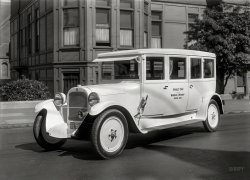
- Rooms for Rent: 1936
- February 1936. "Mission District. Slums of San Francisco, California." 4x5 negative by Dorothea Lange for the Farm Security ...
(The Gallery, Dorothea Lange, Great Depression, San Francisco) ... Posted by Dave - 06/29/2017 - 6:55pm -
![Rooms for Rent: 1936 February 1936. "Mission District. Slums of San Francisco, California." 4x5 negative by Dorothea Lange for the Farm Security Administration. View full size.
NostalgiaAll was not beautiful in days of yore. Unpainted buildings, dirt, and litter was not a stranger back in the day, but clean laundry was still important!
WonderWonder how they managed to get the washing on the high lines. Step ladder. Trapeze artist. Magic!
[Or just by standing on the balcony. The lines are on pulleys. -tterrace]
Fancy BollardThat bollard-like post seems out of place with the studs, wonder how & who did it?
And in 2017$3000 per month.
$3000 per month is a conservative numberAverage rent for a 1BR in the Mission District as of 5/17 is a hair-raising $3,935.00. Whoa.
Edit: "Solved!" <Trash can or horse post?>I (was) waiting for Shorpyites to identify the two-foot round thing in the lower-right of this picture. It looks like it has rivets on it. Is that another one, farther afield, without rivets?
Edit: Further research indicates that the objects are *re-purposed* water heater expansion tanks, usually filled with concrete, and used to protect private property from stray vehicles. Yes, bollards!
I'm always learnin' something on Shorpy!
(The Gallery, Dorothea Lange, Great Depression, San Francisco)](https://www.shorpy.com/files/images/SHORPY-8b13828a.thumbnail.jpg)
- Aunt Mary's Car: 1920
- ... Snelling. Aunt Mary had moved to Merced Falls from (foggy) San Francisco to live in a drier climate near the mountains, which was thought to ... Posted by tterrace - 06/24/2009 - 5:12pm -
![Aunt Mary's Car: 1920 c.1920, in the vicinity of Merced Falls, Calif. My mother's older sister and her car. Maybe someone here can identify it. From original 116 negative. View full size.
Model T Runabout
Mary's CarThe rear license plate seems to say 1928 or 1929---what do others think?
["20." - Dave]
Aunt Mary and Her CarThanks for the auto ID, Anonymous Tipster. As for the date, I'm afraid that Mary died in 1922, of tuberculosis, two weeks shy of her 29th birthday.
Clothes Make The LadySo Aunt Mary was only 26 years old when this picture was taken?
Those clothes make her look at least 50.
Mary's back storyThank you, Aunt Mary's niece, for more about her and her family, poor things. You are right about TB. It was a terrifying disease with an unpredictable but often fatal course. Even worse, there was considerable stigma associated with having it. When my mother-in-law was a child in the 1920s, her father spent several months in a TB sanatorium (he survived, lived a long life and died of something else). She said the children were forbidden to ever speak of it to anyone, for if it was generally known he would lose his job and friends would be reluctant to be with them. She was still uncomfortable talking about it in the 1980s.
Something About MaryShe was a very pretty woman nevertheless.
About Aunt MaryIf this was taken in 1920, Aunt Mary was pregnant with her first child, who was born in October of 1920. What is surprising is that she had her photo taken while pregnant, something most women of that era were too embarrassed to do. (Even in the 1940s our mother was quite chagrined to find out someone took a snapshot of her while she was expecting.)
Aunt Mary's story has an even sadder ending. During her second pregnancy, her tuberculosis, which had been in remission, flared up again, and she died two weeks after the birth of the baby. The baby, being exposed to TB at birth, died of fulminant tuberculosis at age 6 weeks. Mary left a husband and a 2-year-old. Mary was born in June, married in June, and died in June. This was the tragedy of our Mother's family.
We have forgotten today the toll that TB took on people's lives in the early to mid 1900s. Until medication for treatment was developed in the 1940s-50s, TB was one of the top ten killers.
-- Aunt Mary's Niece, who never knew her
Aunt Mary's Clothes"Those clothes" were simply the style of Aunt Mary's era. Yes, today those styles are old-fashioned and pretty silly looking. Just like the clothes we wear today will look old-fashioned and silly looking in 2096 (yes, 2096!). Girls born in 1892 wore those kind of clothes in 1920. Actually, if you take a closer look at Mary, she's pretty easy on the eyes. Some 21st century treatment on her wardrobe, makeup and hair and I'll bet she'd turn a few heads.
TB's Heavy TollMy paternal grandmother contracted TB during my grandfather's courtship of her (started with a cold she got while sitting on the ground watching Granddad play baseball), and died when Dad was 5 (1930). Dad, born with TB, was cured of it at Johns Hopkins during his first 5 years, but still worries about a recurrence to this day- and he's 83 now.
My regret, of course, is that I never got to know my grandmother. Indeed, even my father's memory of her is very sketchy.
Mary's Model TThe car seems to be a ca. 1917-1919 non-starter car. There is an accessory "keyed" ingition switch on the coilbox on the firewall. I put "keyed" in quotes because the stock Ford switch had a key, but they were all the same! I see an electric taillight, which may have been added on. One popular package on 1919 and later cars that had starter motors and generators included demountable rim wheels and an electric taillight. Those cars had no kerosene side lamps. We can't tell if this car has them because of Mary's position. This car does not have demountable rim wheels. The toolbox on the running board is an accessory item. It looks like something on the end of the tail pipe, too. Maybe a warning whistle. It also looks like there is an accessory dashboard, and auxiliary outside brakes on the rear drums. The outside brakes and keyed ignition tell me Mary was a cautious woman.
1917 Model T RoadsterI think the car was a 1917 model year produced around March–April 1917. See the rationale at the Model T Ford Club of America Forum.
Others may see additional items that will alter that recommendation.
Respectfully submitted,
Hap Tucker 1915 Model T Ford touring cut off and made into a pickup truck. Sumter SC.
Merced FallsMerced Falls, 30 miles east of Merced and just a couple of miles south of Snelling, was quite a place in those days. Mostly gold dredging in the Merced River. Not a lot left today. There was a cement factory there also. It was in the foothills of the Sierra Nevada range. There are still a lot of "potholes" filled with water when the dredge would move on to create another hole. The last time I was there (40 years ago) there was still an old dredge in one of the potholes. Great fishing and frogging.
Re Merced FallsMerced Falls was at that time a company lumber town. Aunt Mary was a bookkeeper for the Yosemite Sugar Pine Lumber Company. See her photo with co-workers in "Times of Flu." Aunt Mary and the other unmarried lady employees lived in the Company Hotel. There was housing for families and barracks for the single men. There was a mess hall, pool hall, and a baseball field.
The Lumber company was noted for its Incline Railway system which brought the logs down from the mountains above. The track was 8000 feet long and 3100 feet in height. It started at an elevation of 5000 feet and ended at 1900 ft el. More technical info for train trekkies can be found here.
Aunt Mary married the company town butcher, a young man from a butchering family in England. Later they moved to a house in nearby Snelling. Aunt Mary had moved to Merced Falls from (foggy) San Francisco to live in a drier climate near the mountains, which was thought to be beneficial for tuberculosis. Which it was for a while.
The area today is a county park, the town partly drowned under the waters of Lake McClure, formed by the Merced Falls Diversion Dam.
SnellingMy family has been going to Henderson Park for 50 years especially at Easter.
My uncle Alvin and Grace Halstead have lived near Merced Falls for almost 30 years.
Many great memories of the time spent there.
Tom Mitchell
Killer TBI read with interest the comments on Aunt Mary's pictures and her tuberculosis. Those who wrote that it was a killer are indeed right. My great-grandmother, two great aunts, and one of their sons all died of it within a short time. My grandmother had it when she was pregnant with my mother. She was told that that the baby would either be dead in six months or always immune. Since Mom died at age 72, I guess it was the latter. Her first cousin Edna also had TB and was ill for several years.
The picture is of my grandmother and grandfather in the 1930s. While my grandmother survived TB, she died of a brain aneurysm before I was born.
(ShorpyBlog, Member Gallery, Cars, Trucks, Buses, tterrapix)](https://www.shorpy.com/files/images/marycar2_1.thumbnail.jpg)
- Honolulu Clipper: 1939
- ... Aug. 28, 1939. "Golden Gate International Exposition, San Francisco. General Motors exhibit of GMC trucks with Pan American Airways ... Posted by Dave - 02/10/2015 - 2:57pm -
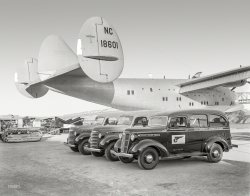
- Scavenger Truck: 1933
- ...
One man's trash ... When I attended college in San Francisco, I learned that scavenger companies were called garbage collectors or ... Posted by Dave - 12/02/2014 - 8:37pm -
![Scavenger Truck: 1933 October 1933. "Kleiber motor truck -- Bay Shore Scavenger Co." An ominous-looking conveyance made all the more foreboding by that toxic telephone exchange. 8x10 acetate negative by Christopher Helin. View full size.
Well equippedSix state-of-the-art cadaver hooks at the back of this conveyance. Ready for anything, but rarely did they need all six unless the Barbary Coast got particularly rambunctious.
One man's trash ...When I attended college in San Francisco, I learned that scavenger companies were called garbage collectors or waste management elsewhere.
HemlockI am very impressed by the sharpness of this photo.
Does anybody know the origin of the choice of Hemlock as an exchange name? If it was a locality why was it so named?
I wonder why the windscreen on this truck (that looks new) appears to be grilled. I would have thought overhead protection of the cab might have been desirable rather than grilles here.
[I suspect they are grab bars, for holding onto while riding standing up. -Dave]
Early stair stepperIt appears that the trash collector would climb up he running board and go up two more steps to load the truck. Note the cutout behind the fender and the hand holds on the windshield.
HEmlock et. al.In San Francisco there were several different Central Exchanges that each had their own set of local exchange prefixes. Many of these survive in phone numbers today if the users have had them for a long time.
My own is KLondike-2 (552), which I've had since the 1970s. Originally there were seven central exchanges but by 1958 there were these four:
In SF the downtown exchange on McCoppin Street had HEmlock, KLondike, MArket and UNderhill.
The Mission exchange on 25th Street had ATwater, MIssion and VAlencia.
The Onondaga Street exchange near Balboa Park had DElaware, JUniper and RAndolph.
And the one at 21 Folsom Street near the Embarcadero (which connected SF with Oakland and points east) had ROchester, EXbrook and WEather.
(The Gallery, Cars, Trucks, Buses, Chris Helin, San Francisco)](https://www.shorpy.com/files/images/SHORPY-154-02.thumbnail.jpg)
- And Step On It: 1917
- San Francisco circa 1917. "Chalmers town car." The ideal conveyance for European ...
(The Gallery, Cars, Trucks, Buses, Chris Helin, San Francisco) ... Posted by Dave - 05/17/2016 - 8:27pm -
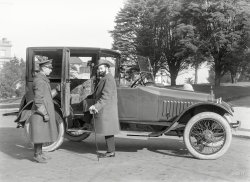
- Blessed Oblivion: 1958
- ... as 'Hube the Cube'), one of the 'Beatnik' community of San Francisco's North Beach district." 35mm negative from photos by Cal ... 59 Years Ago Today The word "Beatnik" was coined by San Francisco Chronicle columnist Herb Caen.
Objecting to the term, Allen ... Posted by Dave - 01/30/2018 - 7:14pm -
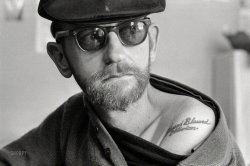
- A Feather in Her Cap: 1920
- San Francisco circa 1920. "Haynes touring car at de Young Museum, Golden Gate ...
(The Gallery, Cars, Trucks, Buses, Chris Helin, San Francisco) ... Posted by Dave - 06/12/2019 - 12:12pm -
![A Feather in Her Cap: 1920 San Francisco circa 1920. "Haynes touring car at de Young Museum, Golden Gate Park." Dapper flapper at the wheel, poised to take flight. Could this be our first photo by Chris Helin to portray someone famous? 5x7 glassneg. View full size.
HintBeethoven's Ninth, Gounod's Faust.
GuessMaybe Geraldine Farrar?
[Not metallic enough. -tterrace]
Another hintThe ghost of John McLaren is pleased that finding the famous is proving to be difficult.
The statues?Goethe and Schiller.
Dynamic duoAre you referring to the statue of Goethe & Schiller almost camouflaged by shrubbery at right?
When this photo was taken, the duo were located near the site of DeYoung Museum. Sometime in the 1920s they were evicted and moved across the Music Concourse to their present location next to the Academy of Sciences.
Could it be...Raymonde Delaunois , who sang in both?
[Not, it's those two guys below who wrote the words. -tterrace]
(The Gallery, Cars, Trucks, Buses, Chris Helin, San Francisco)](https://www.shorpy.com/files/images/SHORPY-1052.thumbnail.jpg)
- The Princess and the Pontiac: 1936
- June 3, 1936. San Francisco. "Woman in Pontiac made into bed." Some cars are just better at ... photo. -tterrace]
(The Gallery, Cars, Trucks, Buses, San Francisco) ... Posted by Dave - 12/20/2014 - 7:52pm -
![The Princess and the Pontiac: 1936 June 3, 1936. San Francisco. "Woman in Pontiac made into bed." Some cars are just better at stopping than going. 8x10 nitrate negative. View full size.
CozyMore elbow room than a 1985 Mazda 626, to be sure, but there is no way you could make it into a 1950s sitcom master suite with separated twin beds.
A mere 33 years laterI had a '63 VW microbus fitted out much like this in the back, although my little rolling bedroom had Budweiser curtains and, usually, no attractive women in it.
Does it comewith bedbelts?
Try the '49 Kaiser Traveler for comparisonMy parents had a 1949 Kaiser "Traveler". The back seat and trunk could be combined to create a double-bed and left that way if there were only two people using the car. They vacationed quite a bit using it. Unlike a tent, it was ready in a minute or two, dry, and comfortable. They would set up a simple tent as a changing room, etc., to hold their space if staying for a number of nights in the same campground. That Kaiser was not the World's Best Car, but it demonstrated that an ordinary-looking sedan could work well as dual purposes.
Just Like the Rambler in the 60'sSome of the 60's Ramblers would do the same. A gal in our high school used to cruise through the local drive-in in her parents' Rambler and brag about how the seat backs would fully recline. She did not have a stellar reputation, as you can imagine. She was not all that attractive, but we didn't care.
Bruce McCallMight possibly have been an artistic plagiarist. That is one really big car.
You Could RambleMy 1961 Rambler (three on the tree) could be converted into a honeymoon suite the same way. Best drive in movie car ever made and well worth the $125.00 it cost me when I got out of the Marines in 1969.
Re: Rambler Folding SeatsBack in the day, a friend of mine had a '59 Rambler with tendency for the front wheels to collapse. You think he got rid of it? He was nineteen or so....
Invitation for what?Seeing the crispness of the sheet and the pillow cases, and the lovely position the wife is in makes me think the guy behind the camera has more than sleep on his mind!
But is it for real?I looked through the 1936 Pontiac brochure:
http://www.oldcarbrochures.com/static/NA/Pontiac/1936%20Pontiac/1936_Pon...
and through the 1937 brochure (thinking it might be a running change addition in 1936 extended to the 1937 models), but there's no mention of reclining front seats in any of the 1936 or 1937 Pontiacs.
[The front seats were removed for this shot. -tterrace]
Pontiac Has GoneJust like those hand cranked windows, road maps and factory installed Kleenex dispensers.
Looks inviting!You gotta love those old cars. I didn't know that was even possible! The front seat appears to be completely removed.
[It was for this promotional photo. -tterrace]
(The Gallery, Cars, Trucks, Buses, San Francisco)](https://www.shorpy.com/files/images/SHORPY-173-01.thumbnail.jpg)
- Ready to Roamer: 1921
- ... was marketed as "the affordable Rolls-Royce."
San Francisco circa 1921. "Roamer roadster." Today's entry on the Shorpy Chart of ... Posted by Dave - 06/24/2017 - 8:49am -
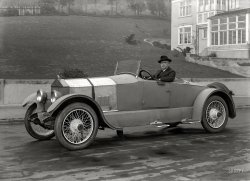
- Dropping By: 1921
- San Francisco, 1921. "Maxwell Model 25 touring sedan." Honey, whose horse was ... it.
(The Gallery, Cars, Trucks, Buses, Chris Helin, San Francisco) ... Posted by Dave - 07/10/2017 - 7:58pm -
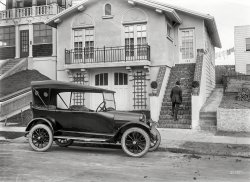
- Petroleum Palace: 1928
- San Francisco, 1928. "Buick sedan at Texaco service station. Jack Tar Hotel site." ... Gallery, Cars, Trucks, Buses, Chris Helin, Gas Stations, San Francisco) ... Posted by Dave - 01/23/2015 - 12:45pm -
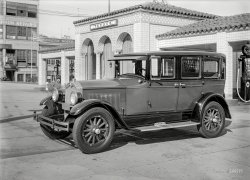
- Candy Man: 1926
- ... with their new street views. The older ones, like in San Francisco, rapidly turn to mush when you zoom in.
[I would say it's kinda ... Posted by Dave - 08/05/2012 - 5:48pm -
![Candy Man: 1926 Washington circa 1926. "Semmes Motor Co. John Fisher truck." The more you look at this, the more you'll see. National Photo glass negative. View full size.
GumdropThe little girl in the window may also be wondering where the candy man is. Special delivery?
[Very good. What else do we notice? - Dave]
Daddy's HomeIs the address on the truck the same as the house? If so, that's one lucky kid. The family dentist must have made a mint off of them.
The address on the vanThe address on the van matches the number on the house? So the girl in the window is probably little Ms. Fisher.
Little Miss FisherI'd say she was the candy man's kid.
[Good. What are some other points of interest? - Dave]
PointsHe's quite protective of his spare tire.
If that thing behind the truck is fire plug, he might be parked illegally.
FireplugIs that a fire hydrant? Never saw one like that.
[That was the first thing that drew me to this photo. -- the Mysterious Pygmy Hydranty Thing. There's a similar one here. Maybe it was some sort of shutoff valve for a water line, or a sewer cleanout. - Dave]
What?!? Daddy's HOME????As Mr. Fisher neglected to mention the midday appointment he had with the National Photo guy, at this moment there's an awkward scene taking place in a back room between Mr. Fisher, Mrs. Fisher and the mailman.
1008 Florida Avenue N.E."Capitol Hill Premium Cigars & Tobacco."
View Larger Map
DetailsLooks like the truck has sliding cab windows, which must have contributed to an "interesting" entry or exit. Is the house a double? That might explain the placement of the ever-so-neatly trimmed hedge.
[Very good. The truck has a two-part door, the upper section with sliding glass. - Dave]
Hurry!I betcha he stopped by to use the can. He left the door wide open. A quick dash and back to work. I can't figure out how those windows work. Does anyone think that they're attached to the door? It's the only truck of that era that I've seen on Shorpy that has a fully enclosed cab.
[The door is in two parts, upper and lower. You would have to open each one separately. - Dave]
The lock on the spare tire.There is a chain and padlock on the spare tire, presumably to prevent someone from walking off with it.
The ThingLooking at the Google street view, it's rather distorted, but you can make out the top part of a new fire hydrant at what appears to be the same location as that pot-bellied old one. So I'm voting for that being a fire hydrant which must have had the valve on the side we can't see, because that sure isn't a valve on top of it. Unless perhaps that top flipped open and there was a valve down inside. If so, you could say for certain they don't make 'em like that anymore.
[It looks way too short to be a fire hydrant. - Dave]
HydrantIf you move one blip to the SE in the Google street view, then pivot around to the left and zoom in all the way, you can clearly see the current hydrant. I found a site that specializes in vintage hydrants (it would be foolish to think that such a thing did not exist) and sent an inquiry. We'll see if we can stump the band.
If that was a two-family dwelling, the family on the left is lucky—they have that nice little porch.
Here's the hydrant geek's reply:
That's a great photo. Is it a fire hydrant? I don't know. It is possible that it is the cover to a fire hydrant of an earlier type. If so, this would be the first documentation for this style fire hydrant in Washington, D.C., we've seen.
Take a look at the Curran hydrant on this page.
This style hydrant is short and is normally hidden beneath the protective cover.
In your photo there appears to be water on the sidewalk and curb near the mystery object, suggesting this is some type of water device.
Could it be a street washer? Street washers were small hydrants used to fill water wagons, for wetting down dusty streets. It's a possibility.
I think this is a matter for an historian or museum in DC to help sort out. Further photographic evidence, such as a hydrant in use with the same style cover sitting next to it would help.
Do let us know if you find out anything more out about this thing. I think that 1926 would be a late date for such an early covered fire hydrant, but you never know.
Either that or somebody left a pony keg on the curb.
The dark sideThe left half of the building looks darker than the right. The line goes from the hedge up to the roof. Could these have been built at separate times? Or is it a trick of the shadows?
[The bricks seem to be painted a different color on each side. Or maybe painted on just one side. - Dave]
Da DoorMany times on delivery vehicles, people would enter and exit from the right, (passenger), side. If you look closely you can see there is no sliding window on the passenger side. There probably isn't a seat on that side and maybe no door either.
The FenceComparing this against the Google street view image, it looks like the delicate iron fence in front of the property survived. This is a minor miracle.
Thanks to gcreedon for posting the Google Street View image. This is always fascinating.
The Candy TruckThe Dodge truck is approximately 1923. Dodge made a lot of commercial units at that time, basically used an open car front cowl and windshield and doors, and modified the back body to suit the use.
You can see "DB" (Dodge Brothers) on the hubcaps. The left rear fender is quite battered. Spare on the left side, with lock, and a neat fender light on the rear at the top, sort of a red and blue marker lamp.
The roadster or touring style left door has an extra sliding window attached, made with a wood frame. Presumably the driver left that affixed, and entered and exited through the curb door.
Urban ArchaeologyI can't shed any light on what the device at the curb is, but I can say that this is one of those things that keep me coming back day after day. I love these little urban archaeological mysteries. This post has a second feature I always find fascinating, which is a modern day comparison shot. Thanks again for the adventures.
John William Fisher Jr.Articles about Mr. Fisher in The Washington Post are rather scarce - perhaps because his business was wholesale rather than retail. The 1920 Census lists John W. Fisher, age 32, living at 1008 Florida with his brother, Edward, age 31, and sister-in-law Rosina.
From the Post, we can learn that the house was originally owned by his father: John W. Sr., who passed away in 1914 at age 49. His mother, Christine, was heir but nothing more is reported on her. Two years later the Real Estate Transfers reveal that the brothers split ownership of the house.
Edward G. Fisher died in 1957 and merited an obituary which reveals that John W. was still living at the 1008 Florida Avenue address at this time. The confectionery business was originally started by John Fisher Sr. and both brothers worked at it after their father's death.
As to the child in the window, Edward and Rosina had at least two children (according to his obit): Elise R. Fisher (who never married) and Edward G. Fisher Jr. (who became a Lutheran minister) - No information on their ages but they seem to have been born after the 1920 Census.
John W. Jr. died Sept 20, 1972, survived by Rosina, Elisa, Edward Jr. and 8 grandnephews. There is no evidence of John having been married or having children. Rosina died Feb. 29, 1980.
The Thing-SpotI see that the place where The Thing once resided now has some metal covers for what look like shutoff valves.
Dark Side of 1008 TodayThe Google Street View also shows evidence of the previously mentioned dark side/light side divisor down the bricks. I note Google has upped the resolution with their new street views. The older ones, like in San Francisco, rapidly turn to mush when you zoom in.
[I would say it's kinda scary-sharp. How long will it be before Google puts a "year" pulldown next to the zoom icon? - Dave]
Looks like a duplexThe hedge centerline seems to match the lighter/darker line, and the very bottom bricks on the left side are painted white, but not on the right side.
[It is a duplex. 1006 on the left, 1008 on the right. - Dave]
Body By FisherCan't help but thinking "Body By Fisher" would be an apt term for any customers rendered portly by overindulging in Mr. Fisher's wares.
Fire HydrantThe item in question is indeed a fire hydrant. They used to be all over the City. I do know where one is now in the Northwest section. Underneath the cap were two 2½-inch outlets with valves.
-- Coz
[Where exactly is it? - Dave]
HydrantThe hydrant is located on the grounds of the Soldiers Home. To clarify what is under the cap. There are two male threaded outlets, each with a hand wheel valve. I have pictures of it but I don't know how to post them here.
Jekyll & HydrantMany thanks to Cosgrove for these photos of the gnomelike hydrant with a hidden personality:
I know this girl!The girl in the picture, the daughter of Edward Fisher Sr., is 89 years old. She is in fact on the way to this very location at this very moment, having just seen this photo courtesy of her niece. She is my aunt, and Ed Fisher Jr. was my dad. Next time I talk to her I'll ask about the hydrant.
Re: Aunt LizDear Aunt Liz,
It is wonderful to hear of your personal connection with this photo and to read that you were able to return to the actual site and visit with the current residents.
Not to be too nosy, but ...
Do you have any memories of the time when this photo was taken or of your experience living at this house?
If you took any photos of your return visit, I am sure the Shorpy community would love to see them.
Would you be willing to share additional thoughts or emotions on visiting the house and neighborhood now?
with gratitude and respect,
Stanton Square
I'm the Girl in the WindowI was thrilled on Friday to see a picture I had never seen before. I drove out to the house with my nephew (one of the eight grandnephews) and niece who were visiting from Vermont. I had a great visit with the present occupants. Thanks for the memories!
[Dear Liz: We are all very happy to meet you! - Dave]
Candy Man's Daughter 2009Miss Fisher, the girl in the window, returned to her old home in December 2009.
Welcome home, Aunt LizI think I speak for all of us when I say, "Wonderful to meet you!"
It continues to amaze me how we keep finding people with connections to so many of the old photos Dave shares with us each day.
MEMORIES OF 1008YES, I REMEMBER THE HYDRANT. WAGONS CAME TO GET WATER FOR STREET CLEANING. SOMETIMES THEY FLUSHED IT OUT INTO THE STREET. THAT WAS FUN.
AND YES, THE HOUSE WAS A DUPLEX BUT WE DIDN'T USE THAT TERMINOLOGY IN THOSE DAYS. WE CALLED IT SEMI-DETACHED. I THINK OUR SIDE WAS PAINTED MORE OFTEN THAN THE OTHER SIDE. HENCE THE DIFFERENT APPEARANCE.
FLORIDA AVE WAS A BUSY STREET. THE OTHER SIDE OF THE AVENUE WAS OUT OF BOUNDS FOR ME BECAUSE CROSSING WAS DANGEROUS. EARLY MORNINGS IN SUMMER THE STREET WAS BUSY WITH FARMERS WAGONS, LATER TRUCKS, HEADED FOR THE FARMERS' MARKET AT FIFTH STREET. WE USED TO GO UP TO THE GALLAUDET FARM TO GET MILK, VEGGIES IN SUMMER AND BEDDING PLANTS FOR MY MOTHER'S GARDEN. AND MY BROTHER AND I PLAYED MAKE-BELIEVE OUT IN GALLAUDET'S OPEN FIELDS.
I WAS BORN (IN THE UPSTAIRS FRONT BEDROOM) IN JULY 1920. I JUST MISSED THE 1920 CENSUS! WHEN I'M 90, I'D LIKE TO VISIT AGAIN TO HAVE MY PICTURE TAKEN WITH MY THREE WHEEL WALKER TO COMPARE WITH A FAMILY PHOTO IN SUMMER 1921 OF ME IN SHIRT AND DIAPER, HOLDING ONTO THE FENCE, WITH MY TEDDY BEAR AND MY KIDDY CAR, ALSO THREE WHEELS. AND I'LL SURELY HOLD ONTO THE FENCE WHICH IS NEW BUT REPLACED ONLY RECENTLY, WE WERE TOLD.
Thanks Aunt LizThank you Aunt Liz for your recent photo and memories of living on Florida Avenue. I used to live a few blocks south of here and really appreciate your accounts of what the neighborhood was like.
H Street Heritage Trail!!This photo will be on a board along the H Street Heritage Trail. The board will stand across the street so everyone will know this building's history. The trail is scheduled to open in March of 2012.
(The Gallery, Cars, Trucks, Buses, D.C., Natl Photo)](https://www.shorpy.com/files/images/32482u.thumbnail.jpg)
- Perfect Timing: 1929
- "La Salle Model 328 roadster, Golden Gate Park, San Francisco, 1929." It's all downhill from here! 5x7 glass negative by ... Posted by Dave - 02/22/2015 - 2:55pm -
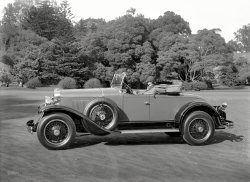
- Mission Trails: 1942
- It's 1942 and we're back in San Francisco for another look at one of the many fine establishments made even ... if there was additional seating upstairs. Would any San Francisco-based Shorpyites be willing to pay a visit to Lori's Diner, which ... Posted by Dave - 08/26/2016 - 1:15pm -
![Mission Trails: 1942 It's 1942 and we're back in San Francisco for another look at one of the many fine establishments made even finer by the installation of Buckley Music System's "Music Box." The eatery is Andy Wong's "Fair Famous" Mission Trails Restaurant, Harvey Lum, manager, at 500 Sutter Street. Close your eyes and you can practically hear Padre tolling the mission bell while the brothers pound out their tortillas. 8x10 inch acetate negative, photographer unknown. View full size.
Triple Selfieof the cameraman. Two in the reflection behind the counter and the third on the right in the back section behind the two waitresses.
The Real Original Formulaof coke from Mexico is good, but better yet is the French version. We were on a trip with my daughters school to France and Spain and brought back cans of French and Spanish Coke. We lined up 4 versions to try in a blind test. We had American, French, Mexican, and Spanish versions and the consensus was that French was the best, followed by Spanish, Mexican and American was dead last. The French version uses better extracts for the flavoring and is outstanding! I don't know if the American version uses natural extracts or not, but I can't drink it anymore.
Coastline in the mirror ?As seen above our hostess' head. Can someone identify it for this Ohio boy?
[Given the California Mission theme of the restaurant, it's most likely a fanciful "olde mappe" of the California coastline, rotated and probably showing the locations of the missions. -tterrace]
In reply to the 'conical shaped devices': I saw several in Key West used to juice citrus fruits. MMMMM. /RZ
Feeling the needIf Shorpy feels the need to destroy images by background overlays of their name, I might as well not come back. I'd hate to see images destroyed.
[All of our photos have that. The watermark isn't "destroying" anything. Without it, we would not have purchased, scanned and published the image, and you never would have seen it in the first place. - Dave]
I understand. Thank you for the reply.
Was the property seized I wonderI wonder if the gentleman lost his establishment during the war and ended up in a concentration camp.
[He's of Chinese descent, so no. - Dave]
Try "Mexican Coke"Indeed! I just finished off 12 bottles of the delicious beverage a friend brought me from Monterrey, Mexico! I hadn't the heart to throw away the bottles and have them lined up on my back porch!
I hope these enterprising people were not among those who were victims of the 1942 Japanese internment.
[They're Chinese. -tterrace]
Conical DeviceIt is an orange juice squeezer. I used to have a less expensive one that I bought second hand back in the 1960s.
Juicer?Are the strange devices you're talking about the juicers?
Don't know whether they served fresh squeezed orange juice, but they may have made lemonade and limeade from fresh fruit.
I used a similar device working the fountain in a drug store.
Where can I get a good malt?The container flanked by the two malt machines contains the malt ingredient necessary for a good “malted milk,” and the probability is very high it’s the Horlicks brand. Back in the dark ages we could buy a good malt for 35 cents, with real ice cream to boot. More often than not the server would bring the metal mixing container filled with the drink to the customer along with an empty glass to drink it from. There was always enough for two full glasses. Darn, those things were good! Can you even find a place these days selling malts?
Things on the backs of chairsAre the small metal bits on the backs of the chairs clips for hats? Or purses? Trying to figure them out.
[Hats. See the other recent cafe photos for more examples of this latest Shorpy Favorite Thing. -tterrace]
JuicedWe still use old juicers like that in many bars and restaurants here in the US Virgin Islands.
Limes for margaritas.
Oranges for Mimosas.
Lemons for cooking.
I found it!By "it" I mean cigarette butt, on the floor between the first two stools on the left.
I'd love to visit that era but I'd probably croak from the fumes.
I'm just a gringo, I guess.I was thrilled to see Mexican Coke at a car dealership promotion recently and took a couple of bottles home. My family did a blind side-by-side taste test against American Coke (with HFCS) out of a plastic bottle. Two of us guessed correctly, and 2 were wrong. Moreover, I personally slightly preferred the American version, even though both were plenty good. Oh well.
Broom Must Be On The FritzThere's cigarette butts on the counter footrest and about 74 years worth of dust behind the main jukebox. If they'd only known how sharp an 8x10 negative is, they might have tidied up a little.
What's upstairs?The curtained staircase in the back looks mysteriously inviting. I wonder if there was additional seating upstairs. Would any San Francisco-based Shorpyites be willing to pay a visit to Lori's Diner, which is now in this location, and give us a new photo of the interior for comparison?
My nostalgia glands needShorpy to give us a readable blow-up of the Music Box offerings.
[Click to enlarge. - Dave]
Re: Unbottled CokeIn the 1920's my mother waitressed at a place that served "mix it in front of you" Coke. The Coca-Cola company used to send around undercover employees to check that the proprietor wasn't skimping on the syrup in the customers' drinks.
Was once a promising mixologist and moreMy father used to have a soda fountain in his store and as young man I used to mix up all types of concoctions.
Vanilla Coke was one of my favorites. When I see a counter like that it recalls memories of all the used chewing gum stuck on the bottom of the counter.
Strange devices...I'm wondering what the two conical shaped devices to the right of the milk shake machines are? Large lever to push something into a cup or glass?
[Are you talking about the ground coffee dispenser and its reflection in the mirror? -tterrace]
Go West, Young ManAt least as far West as the Sunset District near Golden Gate Park. Polk's 1951 SFO directory shows that one Harvey Lum was now a proprietor at new digs located 1239 9th Ave. One can only hope he ported over the great idea of those chair back hat clips. And maybe the idea of the Happy Trails carried over as well. It's now a very highly rated taqueria.
Deja vu, sort ofWas sippin' on a bottled Coke when I pulled this photo up, and the sight of that Coca-Cola soda-jerking-type tap flashed a memory of how very different this particular soft drink tasted back in the '50s, when soda fountains abounded and a Coke was mixed right there in front of me, and served in an actual glass glass with a straw and little ice cylinders, each with a little hole through the center. I sighed, and instantly thought of two things: one, that Cokes don't taste like they did in the old days; and two, that every day, my reminiscences are sounding more and more like those of my late Dad.
I can live with both.
[Try "Mexican Coke," bottled in actual glass bottles and made from the original syrup recipe, with cane sugar instead of corn syrup. - Dave]
Thanks much, Dave. Your reply marks the first I've heard/read of the Mexican, uh, version of the soft drink.
I thinkRBPjr is talking about the orange juicer and its reflection in the mirror.
(The Gallery, Eateries & Bars, San Francisco)](https://www.shorpy.com/files/images/SHORPY-1024.thumbnail.jpg)
- Stop and Go: 1927
- San Francisco, 1927. "Traffic signals -- police officer stops pedestrian crossing ... horn!
(The Gallery, Cars, Trucks, Buses, Gas Stations, San Francisco, W. Stanley) ... Posted by Dave - 03/10/2015 - 3:47pm -
![Stop and Go: 1927 San Francisco, 1927. "Traffic signals -- police officer stops pedestrian crossing against the light in front of Hudson sedan at Bee Garage service station." 8x10 film negative, originally from the Wyland Stanley collection. View full size.
Let's pretendI love the look on the cop and lady's faces. "I'll pretend to stop you from being run over and you pretend to appreciate my efforts." They both have a faint smile as if they are enjoying their time in front of the camera. It also looks like the cement is still wet from the wiring for the stoplight being run in the street.
Love these sweet views into the days gone by. Thanks Dave!
Thanks!Your efforts & bucks are so entertaining to myself & my friends. Thanks for all you do, wishing I could post things like this. Sorry, no $10 words here, just a simple thanx!
SF's ownThe "birdcage" signal, I mean.
Man in white"Well, I'll be. A fine lady, a cop, a photographer, and goodness knows what else."
There's something distinctly otherworldly about that fellow.
S H O R P Y... is just a little distracting over the hood of this car, I think. I like to scrutinize the reflections and ornamental detail, so it's probably just me.
[Shorpy paid $177.50 for this photo, which will be ripped off right and left for sale on eBay and who knows where else in the coming months. Would you say you're getting your money's worth? - Dave]
Absolutely! No offense intended. I understand why it's in the photo. I just meant, that particular placement was where every car lover is going to focus. I've noticed the "watermark" in lots of photos, and they're always tastefully and unobtrusively applied.
Get Out Of the Way!Meanwhile, as the copper saves the young lady from injury or a messy death, he's blocking traffic. The driver looks like he's about to dump the clutch and let 'er rip any second.
Now I see itSo subtle I didn't notice the watermarking until mentioned in the comments. Sad that some people find their joy in endlessly repeating the photos they've ripped from this site all over the web, forcing this to become necessary.
Shorpy watermarksConsidering the amount of fun, laughs, and knowledge Shorpy provides its audience, a subtle watermark on a photo is a small price to pay. I, for one, would be happy to pay an annual subscription fee to enjoy Shorpy.com.
Having spent much time researching photos at the Library of Congress in the pre-internet days, I can't imagine the amount of work Dave and his helpers put in to find these wonderful images. Plus the costs of hosting the site.
And, as long as I'm ranting, the prices charged on this site for prints are VERY reasonable.
I will say no more.
Bumperless car!Maybe they were an option and this is a stripped down model?
Ok, maybe she isn't-But the young lady crossing the street looks a lot like William Randolph Hearst's favorite movie star, Marion Davies. Her height, sense of style and radiant smile all are very similar to Miss Davies' very well-known look in 1927.
Bee GarageWings repaired while you wait, Stingers recharged!
HD on glassThese large format glass plate photos are amazing in their clarity and resolution. Can we say that any digital camera today matches this quality of reproduction?
[This photo was, as noted in the caption, shot on film, not glass. I can say from my experience scanning many examples of both that the quality here is not quite as good as it would be had the image been captured on glass. As for digital cameras -- yes, but they are large and very expensive. - Dave]
Just noticedIt appears the license plates changed formats between 1926 and 1927. (Comparing the Diana 8 to the Hudson.) Looking back at some other pictures did they change format every year?
PropsBoy oh boy, nothing like using an absolutely spanking brand new automobile for this shot. the front end and steering linkage all have a nice gloss to them.
Pre Andy Griffith?Could this be an early version of Mayberry? Deputy Barney Fife helps his sweetheart Thelma Lou across the street, while Goober in his white uniform stands before Aunt Bee's Garage.
I don't post very oftenBut I am a huge Shorpy fan. I check the site almost every day and always enjoy the beautiful photos that are provided for our viewing pleasure. I very rarely notice the Shorpy logo, in fact I had to look hard to find it on this photo. It doesn't bother me a bit. A big thanks to the Shorpy crew for all they do to make my day better.
Oh, go ahead.You'll never get the opportunity again. Blow that horn!
(The Gallery, Cars, Trucks, Buses, Gas Stations, San Francisco, W. Stanley)](https://www.shorpy.com/files/images/SHORPY-277-02.thumbnail.jpg)
- Merry Old Cole: 1919
- San Francisco, 1919. "Cole auto." Climb in, if you can figure out how. The yard ... side.
(The Gallery, Cars, Trucks, Buses, Chris Helin, San Francisco) ... Posted by Dave - 04/28/2015 - 10:54am -
![Merry Old Cole: 1919 San Francisco, 1919. "Cole auto." Climb in, if you can figure out how. The yard last seen here. 5x7 glass negative by Christopher Helin. View full size.
Two doors, one wide aislewaywith all due respect to fellow Shorpy enthusiast T. Water, this beautiful little roadster was in fact a 2-door called the Cole 861 Tuxedo Roadster, which according to a factory ad was "A perfect dream." It has the snappy double-cowl design, "with rear compartment access...provided by a wide aisleway between the front seats." Plus, it was powered by a "giant 70 horsepower" V8 displacing a whopping 5.7 liters.
The addressTaken in front of the still extant 1701 Franklin Street.
IngressDoor latch is probably on the inside. It is a roadster which has no side windows and outside one is not really needed.
[The question is how to get into the back seat. See above. - Dave]
Three DoorsThe Cole was a high-end V8-powered car. This car had three doors. One driver's side and two passenger side. It was not an entirely uncommon body style. Many municipalities had laws regarding entering or exiting a car on the street side.
(The Gallery, Cars, Trucks, Buses, Chris Helin, San Francisco)](https://www.shorpy.com/files/images/SHORPY-324-01.thumbnail.jpg)
- Franklin Gothic: 1919
- San Francisco circa 1919. "Franklin Brougham." A car with an air-cooled engine and ... home in the background is at 3800 Washington Street in San Francisco. It was built in 1904 as an homage/knockoff of the Petit Trianon ... Posted by Dave - 02/16/2016 - 6:29pm -
![Franklin Gothic: 1919 San Francisco circa 1919. "Franklin Brougham." A car with an air-cooled engine and unusual veed windshield. Latest entry in the Shorpy Catalog of Quirky Conveyances. 5x7 glass negative by Christopher Helin. View full size.
Replica ResidenceThe noble home in the background is at 3800 Washington Street in San Francisco. It was built in 1904 as an homage/knockoff of the Petit Trianon on the grounds of the Palace of Versailles in France.
According to zillow.com, there's currently an offer on it for a cool $18 million (give or take a few sous).
Sugar Daddy's House[An impressive edifice, but it's obviously not Spreckels Mansion. - Dave]
Duh! My bad. I spent 30+ minutes on Street View and Images trying to pin it down w/o success.
Unusual in many waysProbably the most unusual thing about the early Franklins is they used a Wooden frame up to about 1928.
[Many, if not most, autos of the era used wooden frames. - Dave]
Thanks for the Memories!A friend of my dad's, Mr. Bill Gewand of Buffalo, New York, had a copy of this car back in the late 1950s. As the old saw goes, he found it in a barn where the farmer was using it as a chicken coupe, although in this case it was true. It took a lot of TLC, but he got the car looking almost as good as the one in this photo and running like a dream. Your picture brought back happy memories, thank you very much.
["Chicken coupe;" haha, very good. -tterrace]
Thug Mansion3800 Washington was also occupied by a squatter for months recently.
YIPPEE!!!!!!My styling favorite car EVER! Besides a lot of unusual standard features like wooden frame and air-cooled engine, the V or "veed" windshield was a Franklin trait up through the mid-20's; available on their closed cars. It doesn't show well in this photo but if you could see a photo of this dream car from the front, it looks like a spaceship. Too cool; thank you, thank you, thank you!
Design Of The FutureAerodynamic Windpusher.
Wooden It Be NiceThough the Franklin was known for having a wooden chassis, few, if any, major auto manufacturers used them.
[Not so, as owners of brass-era and later cars will attest. Maurice Hendry, in "Cadillac: Standard of the World," recalls an anecdote in which an ash-framed Cadillac chassis proved more resistant to being twisted apart than a steel frame. Below, an excerpt from "Making and Selling Cars: Innovation and Change in the U.S. Automotive Industry." - Dave]
Though I am in no position to argue with a man like Mr. Hendry, he is wrong. Every Model T ford ever built had a steel frame. So did every Dodge, every Durant product, every Maxwell, every Sudebaker (after they went to gasoline powered cars). Pierce, Pope, Stanley, Thomas, Stoddard Dayton, Alco, Locomobile, White, just to name a very few used steel frames. As to Mr. Hendry's assertion that Cadillac used a wooden frame, here is an excerpt from The History of Cadillac.
"The 1903 chassis had angle steel frame with two half-elliptic springs front and rear with straight, tubular front axle. The steering wheel was located on the right-hand side with the controls to the right and using adjustable rack and pinion steering gear. The single tube tires were mounted on 56 cm wood wheels with 12 spokes (14 on the prototype)."
Every Cadillac, ever built, had a steel frame
Wood it, or notCould be that the wood "frame" referred to in some places is the wood that "framed" the body of the cars, and not constituted the chassis' structure. Fisher Body ( read GM) didn't cease wooden framed construction until the mid 1930s. Custom built cars, and low production ones lasted even longer.
Re Wooden It Be NiceIs it possible that the word "frame" is being used in different ways? Certainly the Model T and Model A had a great deal of wood in the "frame" that supported the body panels. This was true of many other cars, and is still true of Morgans (the last time I looked). While I don't know of any that used wood for the "chassis" (another ambiguous word) that supports the axles, driveshaft, etc, I wouldn't be terribly surprised if some early ones did so. Here's a link to diagrams of the "body frame" wood for Ts and As:
http://fordwood.com/
(The Gallery, Cars, Trucks, Buses, Chris Helin, San Francisco)](https://www.shorpy.com/files/images/SHORPY-896.thumbnail.jpg)
- Clock-Stopper: 1906
- "Ferry Building, San Francisco, 1906." Aftermath of the earthquake and fire. 8x10 inch dry plate ... map here .
(The Gallery, DPC, Fires, Floods etc., San Francisco) ... Posted by Dave - 07/19/2012 - 4:34pm -
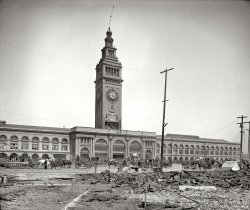
- Sleeps Two: 1920
- San Francisco circa 1920. "Chalmers touring car on Eddy Street." Equipped with what ...
(The Gallery, Cars, Trucks, Buses, Chris Helin, San Francisco) ... Posted by Dave - 10/09/2014 - 6:02pm -
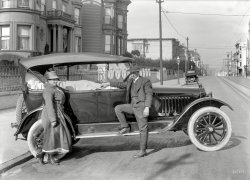
- China Clipper: 1936
- ... Airways 'China Clipper' (Martin M130 Flying Boat) over San Francisco with Coit Memorial Tower at left. Clyde H. Sunderland, commercial and ... Posted by Dave - 07/16/2014 - 12:32pm -
![China Clipper: 1936 July 22, 1936. "Aerial view of Pan American Airways 'China Clipper' (Martin M130 Flying Boat) over San Francisco with Coit Memorial Tower at left. Clyde H. Sunderland, commercial and aerial photographs, Oakland, Calif." View full size.
Powell StThat is indeed Powell St just east of the gas tank, so must be a streetcar we see at the end of it. Looks like the cable car shifted Powell to Mason to Taylor St in 1936 same as it does now.
NC14716Built when flying had class. It was one of three ''Clippers'' built by
Martin for Pan American Airways delivered on Oct. 9th, 1935.
It is interesting to note the that the long lost Fred Noonan was one
of their Navigators.
Powell St. Cable CarThe street just to the left of the large tank is Powell St. and the end of the Powell-Market cable car line. There's one parked there at the end in the picture. The large pier in the center is Pier 41 and the narrow one to its left is Pier 39, now a shopping and entertainment complex and home a very large sea lion population.
M130s met unhappy endsAll three Martin 130s met unhappy ends. One hit a mountain in California, one broke up in a botched landing in the Caribbean and the third vanished over the Pacific.
Clipper memoriesIn 1970 I was having lunch in the dining room of the Bangkok international airport. Near enough to me to hear their conversation were four very British gentlemen. They were deploring the then current state of air travel. They longed for grace, comfort, and pleasure of the Clippers. "It was such a civilized way to travel", I overheard.
Totally AgreeWith those British gents. Now the trip from L.A. to Sydney takes just 14 or so hours compared to the days required in the 1930's. This is Grace and Pace, American style.
Guam stopoverThe China Clipper used to stop in Guam, there's plaques on the pier where she tied up. I remember standing there and imagining what her era of air travel was like.
While in the military I transferred to Guam from Hawaii, the flight took something like 8 hours on a commercial jet. Spending days crossing the pacific while hopping from island to island must've been a surreal adventure.
The round tank below the noseof the plane is a town gas or coal gas storage tank. They were very common near rivers and lakes of U.S. cities from about 1900 until LP or natural gas started taking over about the time of World War II. Made as a byproduct of coke production and much more volatile than its successors, the use of coal gas lasted decades longer in Britain than it did here.
VentilatedI believe that I see an open window, just aft of the starboard sponson.
Rather nice on a Summer day.
A tragic endNC14716 had a tragic end just 9 years later, crashing in Trinidad and killing 23.
Aviation Safety Database
During the second try, the Martin descended too low and contacted the water at more than normal landing speed and in a nose-low attitude at a point 1,25 miles short of the intended landing area. As the plane came to an abrupt stop in the water, the hull broke in two at a point about three feet aft of the hull step and the rear part of the hull was forced up and forward. Water poured into the cabin and major portion of the flying boat sank immediately.
Grace DeniedHaving crossed the Pacific too many times in a DC-6, I can say that low altitude propeller flights of many hours don't leave you in a state of grace but rather a state of turbulent numbness.
Also a state of propeller lag.
Powell St Cable CarStanFlouride points out the cable car to the left of the large tank is Powell St. and the this is the end of the Powell-Market cable car line. This not quite correct, it's the end of the Powell-Hyde Street line. Powell also goes to Mason, a little further left (east). It is interesting to note that the Buena Vista Bar sits at this corner where the tank formally sat and that Ghirardelli Square and the Chocolate Factory now occupies much of the area to the right and up hill from the tank. A row of art galleries now runs right and down Beach street from Hyde-. Well, things do change with time.
[The Powell-Hyde line terminus and the Buena Vista Cafe are five blocks off to the west (right) from the edge of this photo, at the corner of Hyde and Beach. This tank was at the corner of Powell and Jefferson. -tterrace]
Gas Tank tterrace and Timz both make interesting comments but I am wondering if this is not the corner of Laguna. Its near what is now labeled as GAS HOUSE COVE, I wonder if the name has any significance, There are a number of wharfs shown on Mapquest and if one of threes could be one of he ones sown in the photograph. I now question lactating it on Powell and Jefferson, that's Fisherman's wharf, it doesn't look like Fisherman's Wharf to me. I think the street car faked us out and lead us astray.
[Note the sign on the largest pier: "General Steamship Corp." Harbor directories from 1936 list it on Pier 41, located at the foot of Powell St. It's since been reconstructed as a smaller ferry slip in the same location. You can't see Fisherman's Wharf proper because it's off the picture two blocks to the right.]
Ferry ArchwayThat hasn't changed locations over the years, has it? It's pretty obvious in the photo and seems like that's proof positive of the location.
Re: Gas TankThe gas tank at Powell and Jefferson is (barely) identifiable in this 1955 photo. Look along the low area of the S.F. waterfront visible between the Bay Bridge's concrete support pier and one of the towers.
https://www.shorpy.com/node/17002
Another gas tank farther west at Bay and Laguna Streets is easier to spot.
(The Gallery, Aviation, San Francisco)](https://www.shorpy.com/files/images/SHORPY-3c11417u1.thumbnail.jpg)
- Eighteen: 1936
- February 1936. "Mission District. San Francisco, California." Medium format negative by Dorothea Lange for the ... street? Lucky Street?
(The Gallery, Dorothea Lange, San Francisco) ... Posted by Dave - 11/24/2017 - 9:11pm -
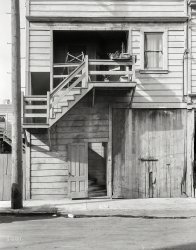
- Three Babes and a Buick: 1926
- San Francisco, 1926. "Girls in Buick at Golden Gate Park." 6½ x 8½ inch glass ...
(The Gallery, Cars, Trucks, Buses, Pretty Girls, San Francisco, W. Stanley) ... Posted by Dave - 07/21/2015 - 3:23pm -
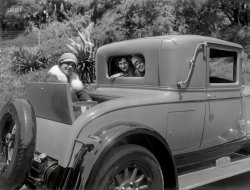
- Car & Drivers: 1919
- 1919. "Paige touring car at San Francisco Golf Club." When a Caddy just isn't enough. 5x7 glass negative by ... wheel.
(The Gallery, Cars, Trucks, Buses, Chris Helin, San Francisco) ... Posted by Dave - 02/01/2016 - 9:59pm -
![Car & Drivers: 1919 1919. "Paige touring car at San Francisco Golf Club." When a Caddy just isn't enough. 5x7 glass negative by Christopher Helin. View full size.
Classy settingIt looks like a scene from Downton Abbey.
Shingles Why do they look like they were put on by 8-year-olds?
[They're imitating the thatched roof on an English cottage. - Dave]
Bearly possibleThat appears to be an image of the California grizzly bear on the license plate, an homage to the short-lived Bear Flag Republic of 1846. Could that bear alternatively indicate that the car's owner is an alumnus of UC-Berkeley and its Cal Bears? I don't know whether association plates were offered that long ago.
[It's a star. Between 1916-1919 the image indicated the year of the plate's registration: 1916-bear; 1917-poppy; 1918-Liberty Bell; 1919-star. -tterrace]
Club house todayCurrent view of club house.
Car DoorsThose small doors make the Paige look even bigger. Easy to see why rear doors are small, but why didn't Paige make the front doors larger. Tight squeeze getting behind that steering wheel.
(The Gallery, Cars, Trucks, Buses, Chris Helin, San Francisco)](https://www.shorpy.com/files/images/SHORPY-889.thumbnail.jpg)
- Clamshell Coupe: 1924
- San Francisco circa 1924. "New Reo Six, Pacific Heights." We'll bet that house is ...
(The Gallery, Cars, Trucks, Buses, Chris Helin, San Francisco) ... Posted by Dave - 04/24/2015 - 8:51pm -
![Clamshell Coupe: 1924 San Francisco circa 1924. "New Reo Six, Pacific Heights." We'll bet that house is finished by now. 5x7 glass negative by Christopher Helin. View full size.
Tire sizeThe tires appear to be 32x4 (4 inches wide on a 32-inch rim). Does anybody know what the 105 / 610 number represents?
[Size in millimeters. - Dave]
Business CoupeWas this the so-called "salesman's coupe" for its ability to carry a lot of samples in a huge trunk?
Shocked by the narrow whitesI thought narrow whitewalls were a new thing when they suddenly (re)appeared in 1962. Apparently not.
Weird measurements105mm is about 4.134 inches (i.e., close enough to 4 for tire purposes); but 610mm is about 24.016 inches, which is pretty far from 32 inches.
[24 inches is the rim size for a 32x4 tire (32 minus 4x2 equals 24). - Dave]
Washington & OctaviaBased on the concrete stairs and the steep angle. The house is there but now behind two others.
(The Gallery, Cars, Trucks, Buses, Chris Helin, San Francisco)](https://www.shorpy.com/files/images/SHORPY-321-01.thumbnail.jpg)
- Cruel Shoes: 1918
- San Francisco. 1918. "Buick at Japanese Tea Garden, Golden Gate Park." ... in the back seat.
(Cars, Trucks, Buses, Chris Helin, San Francisco) ... Posted by Dave - 08/17/2015 - 1:06pm -
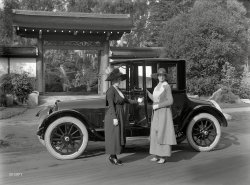
- Cadillac Caliphs: 1932
- ... over the keys to a V-12 Cadillac touring car.
San Francisco, 1932. "Cadillac agency, NE corner Van Ness & O'Farrell." The ... Posted by Dave - 02/13/2015 - 1:12pm -
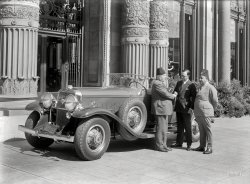
- Vertigo: 1959
- May 1, 1959. "Downtown San Francisco -- California Street East Bay vista from Nob Hill." 8x10 inch acetate ... the Flood Mansion .
(The Gallery, Boats & Bridges, San Francisco) ... Posted by Dave - 07/20/2016 - 2:10pm -
![Vertigo: 1959 May 1, 1959. "Downtown San Francisco -- California Street East Bay vista from Nob Hill." 8x10 inch acetate negative, photographer unknown. View full size.
Adaptive reuseThe Flood Mansion was gutted by the 1906 fire, and it was restored to become the Pacific Union Club, which it remains to this day.
CV-41The aircraft carrier in question is the USS Midway, which was homeported at NAS Alameda. She had just returned from a six-month Westpac Cruise on March 12.
2:23Is that a digital clock on top of the Equitable Life building? If so, some time between 1959 and now we forgot how to stop digital clocks from flashing 12:00.
Church growthMan alive, that modest little church sure has seen some growth.
[No, it didn't grow into Grace Cathedral, which is also in the 1959 shot. Its south tower is partly visible down the left edge. -tterrace]
CV in the BG?Looks like a carrier in the background across the bay? Right where the Hornet museum is today? The image I attached to this shows the area -- the circled dark smudges all could be big ships, but the right half of the dark smudges looks an awful lot like a flat top with its bridge sticking up. Couldn't be the Hornet because that was in the western pacific from April-October 1959.
5/1/59 2:23 pmWell, I'm guessing 2:23, if that's really a "digital" clock display atop the Equitable building.
Previously on ShorpyAt the left, the Flood Mansion.
(The Gallery, Boats & Bridges, San Francisco)](https://www.shorpy.com/files/images/SHORPY-1008A.thumbnail.jpg)























